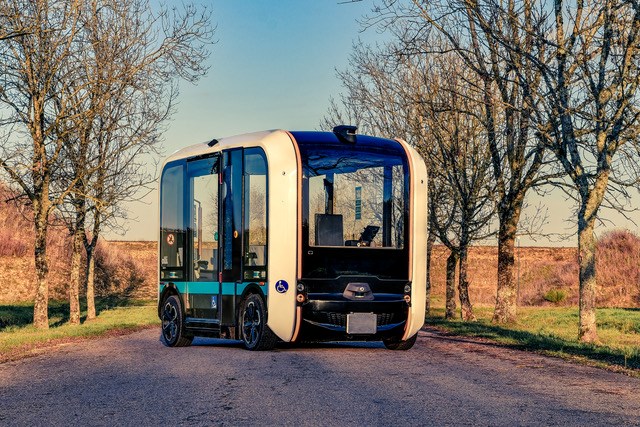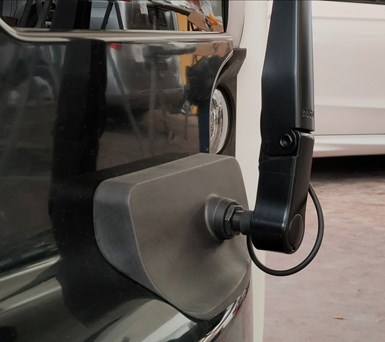Autonomous, electric shuttle retrofitted with CRP Technology Windform materials
Advanced 3D printing production process and Windform composite materials used to manufacture the required motor cover and washer reservoir flap valve components, account for Olli 2.0’s pod-like shape.

The Olli 2.0 model without wipers. Photo Credit, all images: CRP Technology
Ground mobility company Local Motors’ (Phoenix, Ariz., U.S.) autonomous electric vehicle (EV), Olli 2.0, possesses 3D-printed parts manufactured by CRP Technology (Modena, Italy) using its Windform composite materials. Acting as additions to the original Olli 2.0 model developed by the engineering team in Chandler, the parts also support Local Motors’ ability to obtain individual approval in Europe.
“Olli is operating in campuses, stadiums, industrial districts and local communities around the world. To approve deployments in Europe, it needed some additional components not required in U.S. market,” notes Carlo Iacovini, general manager EMEA, Local Motors. This was particularly true due to Olli 2.0’s unique design, which is characterized by a tall rectangular pod with wide-set headlights and expansive windows nestled between a frame (see image above).
Among these additional components were the windshield wipers. “To add the wipers we opted for the retrofit technique, or re-adaptation process, through an integration on the 2.0 model,” Iacovini says. “We started from the original project, and we adapted it to our needs. These phases [retrofit and integration] were carried out in Italy, based on the original design produced by the Chandler engineering team.”
However, because of the shuttle’s shape, “the wipers arm could not be positioned from above, but from the below side of the front window. Thus, Local Motors’ engineering department designed a new front bumper with brackets for fixing both the wipers starter motor and the front wiper washer reservoir.”
During the wipers assembly phase, the Local Motors engineering team noticed that the motor protruded from the modified front bumper: “To avoid the issue we then thought to add two coordinated covers, with the purpose of concealing the protruding part [the first cover] and protecting the pressure system of the washer reservoir from external agents [the second cover],” explains Iacovini.


Olli 2.0’s 3D-printed composite starter motor cover (above) and the cover mounted on the shuttle (below).
To achieve this, Local Motors designed the motor cover from scratch. “For the wipers’ washer reservoir flap valve we modified and adapted the design of the flap valve of the charging socket on Olli 2.0’s rear bumper,” says Iacovini. “In this way we maintained homogeneity from the design point of view, and we positioned the water flap valve symmetrically to the charging one.”
Once the parts to manufacture were identified — the motor cover and the washer reservoir flap valve of the wipers system — Local Motors turned to CRP Technology. “We wanted to collaborate with a European firm,” Iacovini pointed out. “Therefore we contacted CRP Technology, a company I have known for a long time and with which I have collaborated on relevant projects. Relying on CRP was the winning choice: The uniqueness of Windform materials in terms of quality and strength allow achieving optimal results in a short time [possible].”
After a careful study of the projects, CRP Technology experts opted to create the parts using 3D printing/powder bed fusion (PBF) process with fiber-reinforced composites. Specifically, the company went with its Windform Top-Line range: the polyamide-based carbon fiber Windform XT 2.0 material and Windform LX 3.0, a polyamide-based glass fiber. CRP says Windform XT 2.0 was used for the motor cover primarily for aesthetic purposes but also for functionality (i.e., able to contain/support the oscillatory movement of the wiper arm and blade, guarantee electromagnetic compatibility, resist the oscillating movement of the wiper arm and blade, withstand continuous stress and vibrations caused by traffic circulation on roads and preserve the electrical unit from external agents). Alternately Windform LX 3.0 was applied to the washer reservoir flap valve, as it is mainly retains a functional purpose (to ensure quick access to the wipers washer reservoir positioned behind, protect it from external agents and resist continuous stress and vibrations caused by the traffic circulation on roads) and only partly aesthetics.
The resulting starter motor cover for the wipers is a lightweight rectangular part — more specifically a protruding oblique parallelepiped with a puncture for the placement of the wipers arm and a smaller one for the water hose. It features high stiffness, strength and is highly durable. The resulting washer reservoir flap valve component consists of a rectangular structure frame and the flap valve equipped with magnets to access the wipers washer reservoir.
After manufacturing the parts, CRP Technology carried out the final tests and delivery. A Local Motors’ supplier installed them on Olli without encountering any mounting and fixing issues. Additional electromagnetism tests performed showed no critical issues.
Related Content
Bladder-assisted compression molding derivative produces complex, autoclave-quality automotive parts
HP Composites’ AirPower technology enables high-rate CFRP roof production with 50% energy savings for the Maserati MC20.
Read MoreActive core molding: A new way to make composite parts
Koridion expandable material is combined with induction-heated molds to make high-quality, complex-shaped parts in minutes with 40% less material and 90% less energy, unlocking new possibilities in design and production.
Read MoreAutomated robotic NDT enhances capabilities for composites
Kineco Kaman Composites India uses a bespoke Fill Accubot ultrasonic testing system to boost inspection efficiency and productivity.
Read MoreImproving carbon fiber SMC simulation for aerospace parts
Simutence and Engenuity demonstrate a virtual process chain enabling evaluation of process-induced fiber orientations for improved structural simulation and failure load prediction of a composite wing rib.
Read MoreRead Next
CRP Technology celebrates 25 years of 3D printing advancements
Founded in the late 1990s, CRP Technology continues to strive for bold innovation and strong contributions through the evolution of its Windform materials and high-performance electric vehicles.
Read MoreCarbon fiber, additive manufacturing enhance Pleko spike shoe performance
Developed with 3D scanning support from Diadora and CRP Technology’s Windform SP carbon fiber-filled composite material and 3D printing process for a track shoe that meets individuals’ needs in terms of foot structure and athletic performance.
Read MoreAll-recycled, needle-punched nonwoven CFRP slashes carbon footprint of Formula 2 seat
Dallara and Tenowo collaborate to produce a race-ready Formula 2 seat using recycled carbon fiber, reducing CO2 emissions by 97.5% compared to virgin materials.
Read More


























